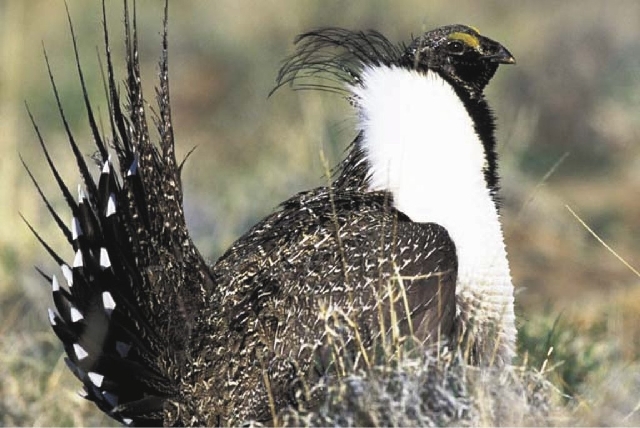BLM plan for sage-grouse habitat draws challenge

RENO, Nev. — A conservation group is asking a federal judge to set aside federal land managers’ plans to remove sagebrush, pinion pines and junipers across a large swath of public lands in eastern Nevada.
The Western Watersheds Project contends that the Bureau of Land Management’s plans to mow, chop, burn and poison sagebrush in Cave and Lake valleys south of Ely will harm habitat for imperiled sage grouse and other wildlife.
The case was filed in U.S. District Court in Boise, Idaho, last month because it’s a companion to a bigger lawsuit challenging the BLM’s management plans for 16 separate areas across the West.
The Idaho-based watersheds project argues that the Ely-area plan affecting 145,000 acres will cause a cheat-grass invasion and fragment the range for the benefit of livestock in what Nevada wildlife officials call “essential and irreplaceable Greater sage-grouse habitat.”
Sage grouse mainly eat sagebrush, while nonnative cheat grass has been blamed for fueling major wildfires across the West.
“Ely BLM is conducting wildly expensive sagebrush and pinion-juniper destruction projects that are catapulting cheat grass invasion into plant communities that had little cheat grass before,” group spokeswoman Katie Fite said. “They are destroying the best of the best remaining habitat — right by the only remaining leks (sage grouse mating sites) across much of the southern margin of sage-grouse range in Nevada.”
BLM spokeswoman JoLynn Worley said the agency has a policy of not commenting on lawsuits.
BLM officials have said their watershed restoration plan for Cave and Lake valleys is designed to reduce the potential for major wildfires and to improve habitat for sage grouse and other wildlife over the long run. They maintain that a lack of natural disturbance due to a combination of drought, fire suppression and historic livestock grazing has helped result in high fire danger.
While the plan’s adverse impacts may include establishment of nonnative vegetation after treatment and short-term eyesores, BLM officials said, it will improve the health of the watersheds by restoring natural vegetative conditions and reducing the risk of catastrophic wildfire.
The plan also will not affect the number of cattle permitted to graze in the watersheds. The Western Watersheds Project accuses the BLM of ignoring livestock’s negative impact on sage-grouse habitat.
U.S. Sens. Jim Risch, R-Idaho, and Dean Heller, R-Nev., have expressed concern that the Interior Department appears likely to list the sage grouse as an endangered species. Offering protections for the bird under the Endangered Species Act could severely restrict ranching, grazing, mining and other activities on public land in their states, the senators said.
The population of the chicken-sized bird has declined for decades, and it now occupies only about half of its original year-round habitat.












